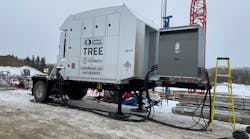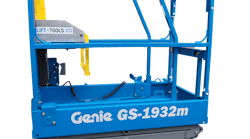If you're going to have an international conference about noise, what better place for a little peace and quiet to do so than Honolulu, Hawaii? Honolulu was the venue for this past December's 35th International Congress and Exposition on Noise Control Engineering, INTER-NOISE 2006. With the theme, "Engineering a Quieter World," the conference addressed all sorts of noise-related issues, from helicopters, to acoustical comfort in buildings, to the effects of loud music.
Of particular interest to pavement experts attending INTER-NOISE 2006, however, were the 19 technical papers (presented by researchers from 11 countries) that focused on various aspects of a common global concern: "Tire Noise and Quiet Pavements."
When we recently asked the American Concrete Pavement Association for its list of top industry concerns, "tire/pavement noise and surface characteristics" was second only to "traffic congestion." The importance of the issue is understandable, because as population increases in proximity to high-volume, high-speed roadways, or, as these types of roadways are built through populated areas, the problem of traffic noise becomes ever more severe.
While traffic noise includes that from engines, engine exhausts, drive trains and vehicle aerodynamics, studies detailed in the Tyre/Road Noise Reference Book, authored in 2002 by Ulf Sandberg (Swedish National Road and Transport Institute) and Jerzy Ejsmont (Technical University of Gdansk, Poland) indicate that the tire/pavement interface is a predominant contributor to the overall noise problem at highway speeds.
At present, diverse research efforts are directed toward the issue (as evidenced at the INTER-NOISE 2006 conference), and prominent among these efforts is an ambitious, seven-year, multi-phase project — the Concrete Pavement Surface Characteristics Program (CPSCP). Taking the lead in this project is a coalition of organizations with a stake in the concrete-paving industry, including the National Concrete Pavement Technology Center at Iowa State University, the Federal Highway Administration and the American Concrete Pavement Association.
Other organizations also are lending their expertise, including the International Grinding and Grooving Association, Iowa Highway Research Board and The Institute for Safe, Quiet and Durable Highways. The latter organization is a joint venture of the schools of civil and mechanical engineering at Purdue University and the Pennsylvania Transportation Institute at Pennsylvania State University.
The broad objective of the CPSCP is to optimize concrete pavement surface characteristics that address noise, without compromising smoothness, friction and other functional elements of the pavement, says Robert Rasmussen, PhD, P.E., who serves as the project's principal engineer.
"The overall surface-characteristics issue is extremely complex, since noise is closely tied to smoothness, friction, splash-and-spray and other pavement-structure and materials properties," says Rasmussen, whose day job is vice president/chief engineer for The Transtec Group, an engineering and research firm (based in Austin, Texas) that specializes in pavement issues.
The time, effort and resources being poured into quiet-pavement research by the concrete-paving industry are directed toward the practical goal of refining the way concrete pavements are designed, placed and finished.
"As we are now entering the third part of the [CPSCP] study," says Rasmussen, "the focus will be turned heavily to developing practical guidance for both the owner-agencies and contractors about how to build quieter concrete pavements that are also safe and smooth."
We were introduced to the mechanics of noise generation at the tire/pavement interface through a technical paper published in 2005, "An Introduction to Tire/Pavement Noise," authored principally by Robert Bernhard, PhD, P.E., and Roger Wayson, PhD, P.E. (Bernhard is associate vice president for research/professor of mechanical engineering at Purdue University and director of the Institute for Safe, Quiet and Durable Highways; Wayson is professor of civil and environmental engineering at the University of Central Florida.) The paper included a summary of tire/pavement interaction based on the findings of Sandberg and Ejsmont.
According to Sandberg and Ejsmont, generation of sound at the tire/pavement interface (or contact patch) results principally from four phenomena: tread vibration, air pumping, slip-stick, and stick-snap.
Tread, or tire-carcass, vibration results as the tread blocks of the rotating tire strike the pavement at an oblique angle. The second phenomenon, air pumping, results from the rotating tire forcing air from the front of the contact patch, compressing the air within the tread grooves, and then pulling in air at the rear of the contact patch. This process creates an "aerodynamically generated sound" similar "to the sound created by clapping hands."
The slip-stick phenomenon results as the tread block transfers acceleration and braking forces to the pavement, generating horizontal forces that may cause the tread block to slip momentarily (if the limit of friction is exceeded). The slip is arrested when the tread block subsequently sticks again to the pavement. These rapid slip-stick events generate both noise and vibration, similar to "athletic shoes squeaking on a playing floor."
The stick-snap phenomenon occurs at the rear of the contact patch when the rotating tire pulls the tread block away from the pavement. Breaking the tread block's adhesion to the pavement ("like removing a suction cup") generates sound and vibration.
In addition, say Sandberg and Ejsmont, other forces are at work to enhance, or "radiate," the sound generated by these tire/pavement interface phenomena. Among them is the geometry formed by the tire and pavement (just above the ends of the contact patch) that creates a "horn" for amplifying sound emanating from these areas. Also contributing to radiated sound are the distorted tread passages in the contact patch, which "take on shapes of acoustical systems that enhance sound generation" in a fashion similar to that of a pipe organ or to that of blowing across the top of an open bottle (the latter known as Helmholtz resonance).
Measuring the sound generated as high-speed traffic passes over the pavement is among the researcher's fundamental challenges, and a number of methods are employed. The "statistical pass-by" method, for instance, measures the sound of a random mix of vehicles, one at a time, with a roadside microphone. The "controlled pass-by" method is essentially the same, except that only a few select vehicles are used and are driven by at controlled speeds. These methods measure all sources of highway sound, while "close-proximity" methods use microphones or "intensity probes" located near the contact patch to more specifically measure either the pressure or intensity of sound in that area.
While the design of a specific tire may have an effect on the characteristics of the sound (or noise) generated as a vehicle travels at high speed across a concrete roadway, it's probably safe to say that pavement texture is the primary determinant of sound generation.
Pavement texture (or surface-profile characteristics) is classified into four "ranges," according to information we first reviewed in the report, "Evaluation of U.S. and European Concrete Pavement Noise Reduction Methods." (This CPSCP report is published by the National Concrete Pavement Technology Center.)
These surface-texture classifications — micro-texture, macro-texture, mega-texture and roughness — are based on the "spacing between the crests of sequential (repeating) surface features." According to the report, "roughness" features have repeating crests of 20 inches or more (faulted transverse joints, for example), while "mega-texture" features repeat themselves every 2 to 20 inches (transverse cracks, perhaps). These surface characteristics, says the report, typically result from poor construction, surface deterioration or settlement, and they have minimal effect on noise generation.
"Macro-texture" features have repeating crests that occur in a pattern of 0.02 to 2.0 inches, "a pattern that may be created by grooving, indenting or otherwise forming small channels in the pavement surface." According to the report, which in turn cites other sources, macro-texture is important, "because it is not only a primary contributor to pavement noise, but also a factor in many other pavement-surface characteristics, including friction and splash-and-spray."
The report states that "micro-texture" consists of surface irregularities typically spaced at less than 0.02 inches apart, and not readily visible to the naked eye. Micro-texture features include textures created by fine sands and the surface roughness of exposed aggregate particles. Micro-texture likely has more effect on a pavement's frictional characteristics than on its noise-generation characteristics.
Measuring pavement texture, with an eye toward coordinating results with noise-generation potential and other characteristics, is a complex process. The CPSCP is addressing the issue and has, among other research efforts, developed a robotic texture-measuring system (RoboTex). The CPSCP, so far, has evaluated more than 1,000 pavement surfaces, says Rasmussen, with the objective of "measuring and analyzing conventional texturing variations and grinding techniques...particularly with respect to tire/pavement noise."
Among the conventional texturing methods the CPSCP is investigating are the drag textures (artificial-turf and burlap) and tined textures (transverse, skewed and longitudinal). You can read preliminary conclusions about how these "macro-texturing" methods affect pavement performance and noise by bringing up an online copy of "Evaluation of U.S. and European Concrete Pavement Noise Reduction Methods."
Also being analyzed is the diamond grinding technique, which uses closely spaced diamond saw blades on a common shaft to produce 50 or 60 grooves per foot. The CPSCP report cites research that indicates the technique can reduce tire/pavement noise and restore pavement friction.
Interesting to note is the report's observation that, although diamond grinding has been used primarily for existing-pavement rehabilitation, its noise-reducing potential "raises the possibility of using the technique as an initial texturing method for newly placed concrete pavements." According to the report, the grinding procedure results in a beneficial macro-texture and, in some instances, enhances micro-texture. But, that said, other researchers caution that economic considerations for extensive diamond grinding still must be evaluated.
Among the possibilities that the CPSCP is investigating for creating quieter macro-textures are techniques such as "dimpling or waffling" fresh concrete — processes that will provide more desirable surface characteristics than conventional tining, but at about the same cost. One idea is to machine a "corduroy-like" macro-texturing pattern into the slipform paver's profile pan. Other ideas include sprinkling and partially embedding small stone chips into the fresh-concrete surface, as well as shotpeening cured surfaces.
Future pavement designs, says the report, may specify concrete with inclusions of fiberglass, foam or rubber particles to "increase acoustical absorption." Or, acoustically absorptive material may be used in pavement shoulders (not driving lanes) to intercept noise before it reaches human ears.
Two other pavement-design ideas with noise-reducing potential also are advanced in the report: exposed aggregate pavement and pervious or porous pavement. The former is routinely used in Europe to mitigate roadway noise, and the technique essentially involves placing a thin lift of concrete — containing small, premium aggregate — over the still-wet surface of a thicker conventional lift, then brushing or spraying the surface with water to partially expose the aggregate before curing occurs.
While pervious or porous concrete is starting to be used to control water run-off from surfaces such as parking lots and low-volume access roads, its use for high-volume, high-speed roadways is still experimental. That said, however, the technique is gaining considerable attention, because of its acoustical absorption potential.
Professors Bernhard and Wayson state in their "An Introduction to Tire/Pavement Noise" that porosity levels of 18 to 25 percent in these pavements assist in reducing noise by diminishing the effect both of air pumping and of the noise-enhancement phenomena.
To come full circle, back to INTER-NOISE 2006, a team of Japanese researchers there presented a paper about techniques for diagnosing a porous pavement's health, that is, for determining if mud, sand and tire-rubber debris collecting in the pavement's sound-absorbing air gaps have diminished its ability to attenuate noise at the contact patch.
 Exposed aggregate pavement, such as this roadway in a Belgium roundabout, results from placing a thin lift of concrete — containing small, premium aggregate — over the still-wet surface of a thi
Exposed aggregate pavement, such as this roadway in a Belgium roundabout, results from placing a thin lift of concrete — containing small, premium aggregate — over the still-wet surface of a thi




